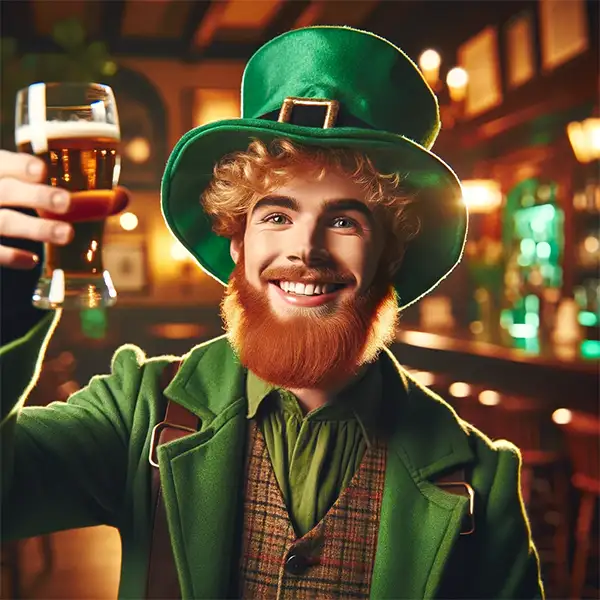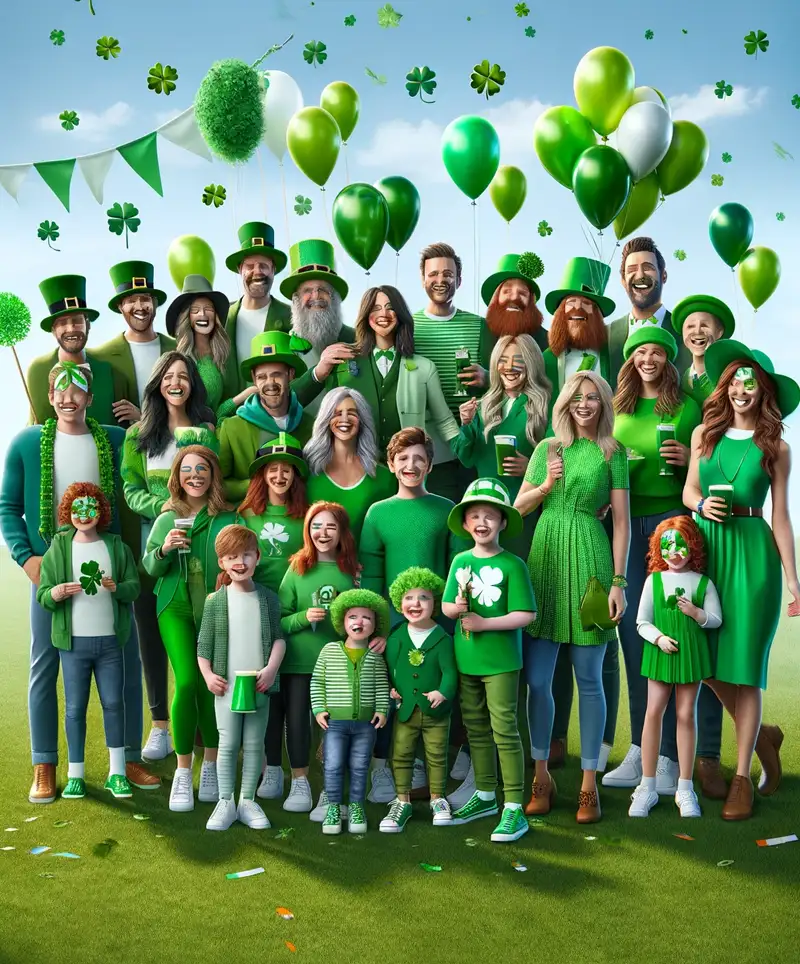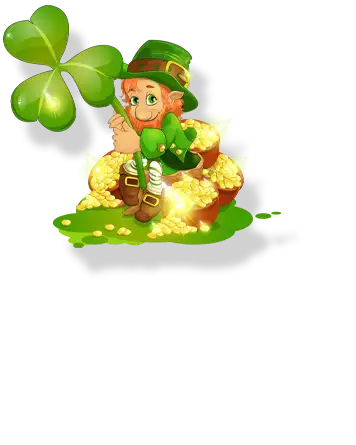More Than Just Green Beer
Every March 17th, a spectacular phenomenon occurs, transforming cities, towns, and even rivers into shades of vibrant emerald. Saint Patrick's Day, a festivity steeped in history, culture, and a fair share of mystique, sweeps across the globe, inviting everyone to don their greenest garb, indulge in Gaelic traditions, and perhaps partake in the lively consumption of green-tinted beverages. What began as a religious feast day for the patron saint of Ireland has morphed into an international celebration of Irish heritage, complete with parades, music, and an all-you-can-eat buffet of folklore and fun. From the shores of Ireland to the farthest corners of the world, this day brings together people of all backgrounds to celebrate, laugh, and enjoy a communal spirit of joy and whimsy. Whether you're Irish by blood or just for the day, Saint Patrick's Day offers a magical escape into a world where everyone can share in the luck of the Irish.
The Man Behind the Myth
First, let's address the elephant in the room—the lack of snakes. Contrary to popular belief, Saint Patrick didn't actually rid Ireland of snakes. This might have been a metaphor for his efforts to diminish pagan practices, but if you're picturing a saint chasing serpents with a stick, you might be a tad disappointed.
 Patrick wasn't even Irish! Born in Britain around the end of the 4th century, he found his way to Ireland courtesy of some not-so-friendly pirates. After a stint as a shepherd and finding religion, he decided Ireland was the place to be for spreading Christianity. Talk about turning a bad situation around!
Patrick wasn't even Irish! Born in Britain around the end of the 4th century, he found his way to Ireland courtesy of some not-so-friendly pirates. After a stint as a shepherd and finding religion, he decided Ireland was the place to be for spreading Christianity. Talk about turning a bad situation around!
Shamrocks
The humble shamrock, a sprig with three leaves, is synonymous with Saint Patrick's Day and carries a weight of significance far beyond its simple appearance. This unassuming plant, often confused with its luckier four-leaf cousin, has roots deeply entangled in Irish history and folklore, playing a pivotal role in the celebrations of March 17th.
Legend has it that Saint Patrick, in his quest to enlighten the Irish about Christianity, seized upon the shamrock to illustrate the concept of the Holy Trinity—the Father, the Son, and the Holy Spirit—using its three leaves as a visual guide. This simple yet effective teaching tool cemented the shamrock's place in Irish culture and Christian missionary work in Ireland. Over the centuries, the shamrock evolved from a religious symbol to a national emblem, embodying the spirit and resilience of the Irish people.
On Saint Patrick's Day, the shamrock transforms from a humble plant into a potent symbol of identity and celebration. It adorns everything from clothing to accessories, becoming a vibrant expression of heritage and pride. The tradition of wearing a shamrock dates back several centuries, with early accounts suggesting that it was worn as a badge on the lapel as a sign of solidarity and nationalism, especially during times of English rule when displaying Irish symbols was a form of quiet resistance.
In modern celebrations, the shamrock's presence is ubiquitous and has taken on a playful tone. Revelers paint shamrocks on their faces, wear flashing shamrock necklaces, and even don green hats topped with oversized shamrock motifs. Yet, even amidst the festive adornments, the shamrock remains a symbol of the enduring spirit of the Irish people and their ability to blend tradition with celebration.
The wearing of green and adorning oneself with shamrocks on Saint Patrick's Day also ties into Irish folklore concerning leprechauns—those mischievous fairy folk said to pinch anyone not wearing green. This whimsical tradition adds an element of fun and encourages participation in the festivities, whether you're in Ireland or celebrating across the globe. It's a nod to the enchanting tales that pepper Irish storytelling, bringing a sense of whimsy and playfulness to the day.
While the shamrock is most visible on Saint Patrick's Day, its significance and the values it represents—unity, pride, and faith—resonate throughout the year. It's a reminder of Ireland's rich history, its struggles, and the joyous spirit of its people. So, when you pin that shamrock to your lapel or don that green hat, remember you're partaking in a tradition that spans centuries, a small act that connects you to the heart of Ireland.
In embracing the shamrock, we not only celebrate Saint Patrick and the arrival of Christianity in Ireland but also the rich tapestry of Irish culture and history. The shamrock, in its simplicity, embodies the complex identity of Ireland and its people, making it far more than just a fashion statement on Saint Patrick's Day.
The World Joins In
Saint Patrick's Day is celebrated worldwide, with everyone embracing the Irish spirit for a day. Chicago dyes its river green, a tradition that's been going strong since 1962. Even the International Space Station has been known to celebrate, with astronauts donning green and enjoying traditional Irish fare. Clearly, the allure of the day knows no bounds, terrestrial or otherwise.
While corned beef and cabbage might be the dish most associated with the day, it's actually more of an American-Irish tradition. Back in Ireland, you might find folks enjoying a hearty plate of Irish stew, colcannon, or soda bread. And let's not forget the vast array of Irish whiskeys and, of course, Guinness, which might just flow a little more freely on this day.
At its heart, Saint Patrick's Day is a celebration of Irish culture, history, and the enduring spirit of a people known for their storytelling, warmth, and hospitality. It's a day when everyone can be a little Irish, share a laugh, and perhaps enjoy a pint or two in good company.
So, this Saint Patrick's Day, whether you're decked out in green, enjoying a parade, or just spending time with friends, remember to toast to the saint who started it all. And maybe, just for a day, we can all believe in a little bit of magic.
Sláinte!
Please Share our Content






 Patrick wasn't even Irish! Born in Britain around the end of the 4th century, he found his way to Ireland courtesy of some not-so-friendly pirates. After a stint as a shepherd and finding religion, he decided Ireland was the place to be for spreading Christianity. Talk about turning a bad situation around!
Patrick wasn't even Irish! Born in Britain around the end of the 4th century, he found his way to Ireland courtesy of some not-so-friendly pirates. After a stint as a shepherd and finding religion, he decided Ireland was the place to be for spreading Christianity. Talk about turning a bad situation around!








 "Sláinte!" is a traditional Irish expression used as a toast, equivalent to "Cheers!" in English.
"Sláinte!" is a traditional Irish expression used as a toast, equivalent to "Cheers!" in English.